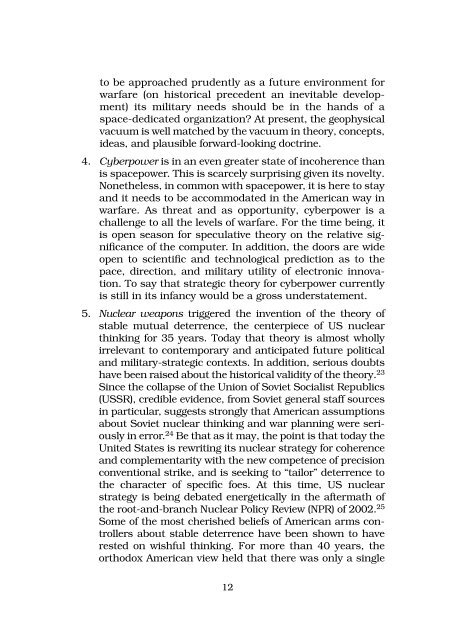The Airpower Advantage in Future Warfare
the Airpower Advantage in future Warfare - Air University Press
the Airpower Advantage in future Warfare - Air University Press
You also want an ePaper? Increase the reach of your titles
YUMPU automatically turns print PDFs into web optimized ePapers that Google loves.
to be approached prudently as a future environment for<br />
warfare (on historical precedent an <strong>in</strong>evitable development)<br />
its military needs should be <strong>in</strong> the hands of a<br />
space-dedicated organization? At present, the geophysical<br />
vacuum is well matched by the vacuum <strong>in</strong> theory, concepts,<br />
ideas, and plausible forward-look<strong>in</strong>g doctr<strong>in</strong>e.<br />
4. Cyberpower is <strong>in</strong> an even greater state of <strong>in</strong>coherence than<br />
is spacepower. This is scarcely surpris<strong>in</strong>g given its novelty.<br />
Nonetheless, <strong>in</strong> common with spacepower, it is here to stay<br />
and it needs to be accommodated <strong>in</strong> the American way <strong>in</strong><br />
warfare. As threat and as opportunity, cyberpower is a<br />
challenge to all the levels of warfare. For the time be<strong>in</strong>g, it<br />
is open season for speculative theory on the relative significance<br />
of the computer. In addition, the doors are wide<br />
open to scientific and technological prediction as to the<br />
pace, direction, and military utility of electronic <strong>in</strong>novation.<br />
To say that strategic theory for cyberpower currently<br />
is still <strong>in</strong> its <strong>in</strong>fancy would be a gross understatement.<br />
5. Nuclear weapons triggered the <strong>in</strong>vention of the theory of<br />
stable mutual deterrence, the centerpiece of US nuclear<br />
th<strong>in</strong>k<strong>in</strong>g for 35 years. Today that theory is almost wholly<br />
irrelevant to contemporary and anticipated future political<br />
and military-strategic contexts. In addition, serious doubts<br />
have been raised about the historical validity of the theory. 23<br />
S<strong>in</strong>ce the collapse of the Union of Soviet Socialist Republics<br />
(USSR), credible evidence, from Soviet general staff sources<br />
<strong>in</strong> particular, suggests strongly that American assumptions<br />
about Soviet nuclear th<strong>in</strong>k<strong>in</strong>g and war plann<strong>in</strong>g were seriously<br />
<strong>in</strong> error. 24 Be that as it may, the po<strong>in</strong>t is that today the<br />
United States is rewrit<strong>in</strong>g its nuclear strategy for coherence<br />
and complementarity with the new competence of precision<br />
conventional strike, and is seek<strong>in</strong>g to “tailor” deterrence to<br />
the character of specific foes. At this time, US nuclear<br />
strategy is be<strong>in</strong>g debated energetically <strong>in</strong> the aftermath of<br />
the root-and-branch Nuclear Policy Review (NPR) of 2002. 25<br />
Some of the most cherished beliefs of American arms controllers<br />
about stable deterrence have been shown to have<br />
rested on wishful th<strong>in</strong>k<strong>in</strong>g. For more than 40 years, the<br />
orthodox American view held that there was only a s<strong>in</strong>gle<br />
12
















